Kopnin N.B. Theory of Nonequilibrium Superconductivity
Подождите немного. Документ загружается.

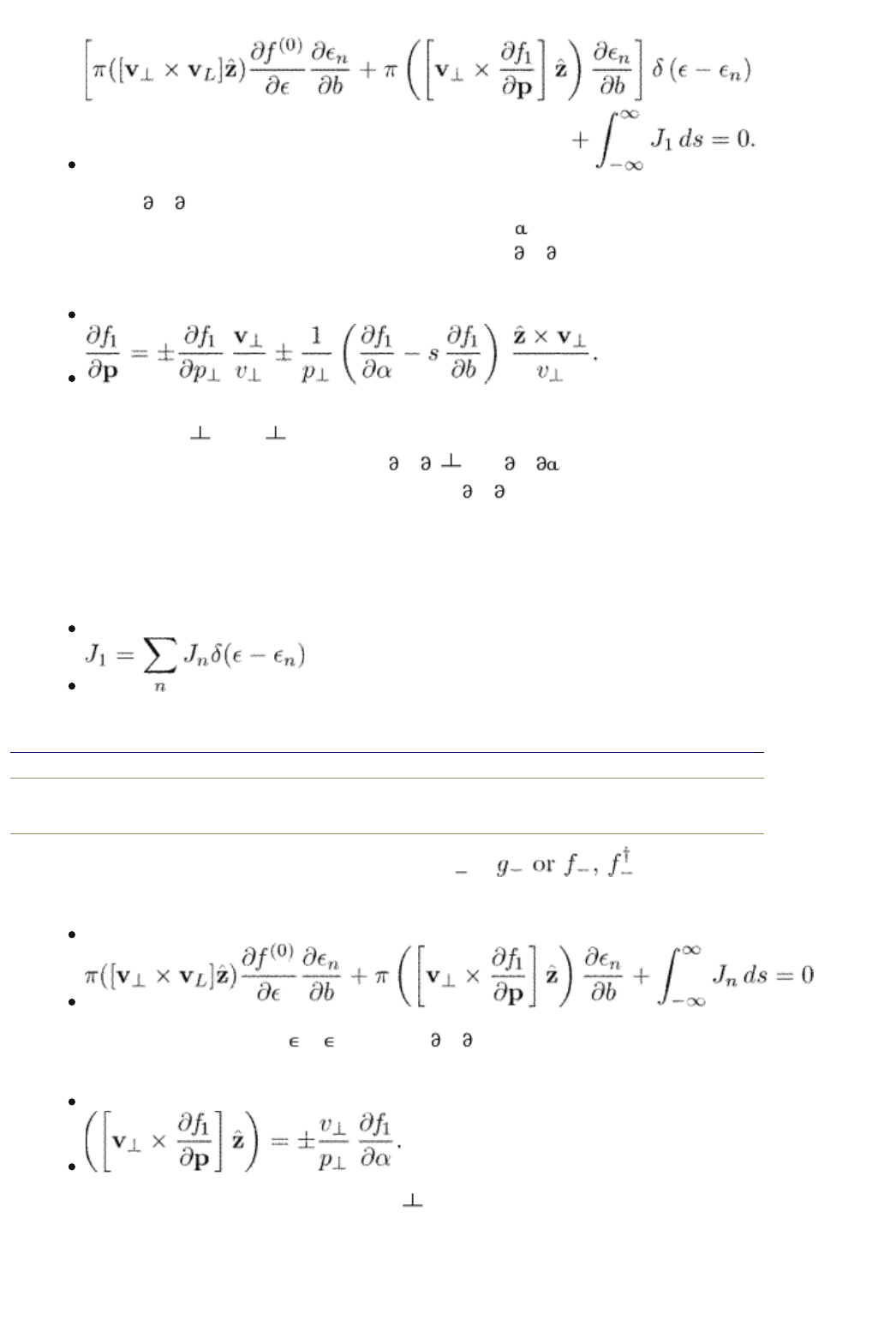
We find
We use that f
1
/ p is constant along the trajectory. Consider this in more detail.
The distribution function f
1
depends on the variables p
z
, , b, where p
z
is the
momentum along the z-axis. The momentum derivative
f
1
/ p can be presented
as
(14.40)
The plus sign is for quasi-electrons while the minus sign is for quasi-holes, since
the directions of v
and p are either the same or opposite for these two types
of quasiparticles, respectively. The terms
f
1
/ p and f
1
/ in eqn (14.40) are
indeed constant along the trajectory but the term
f
1
/ b is not. However, one
can show that this term vanishes identically for an axisymmetric vortex in
s-wave superconductors. We shall prove this later in Section 15.3 in a more
general form.
The collision integral can be also presented as a spectral sum
(14.41)
end p.283
because it contains terms proportional to either g or . The
kinetic equation becomes
(14.42)
where ail terms are taken, at =
n
The term f
1
/ p in eqn (14.42) should be
now understood as
(14.43)
The component in eqn (14.40) parallel to v drops out of eqn (14.42).
14.4.1.1 Low temperatures
The integro-differential equation (14.42) can hardly be solved analytically in a
PRINTED FROM OXFORD SCHOLARSHIP ONLINE (www.oxfordscholarship.com)
© Copyright Oxford University Press, 2003-2010. All Rights Reserved
Oxford Scholarship Online: Theory of Nonequilibrium Supe... http://www.oxfordscholarship.com/oso/private/content/phy...
第4页 共6页 2010-8-8 16:08
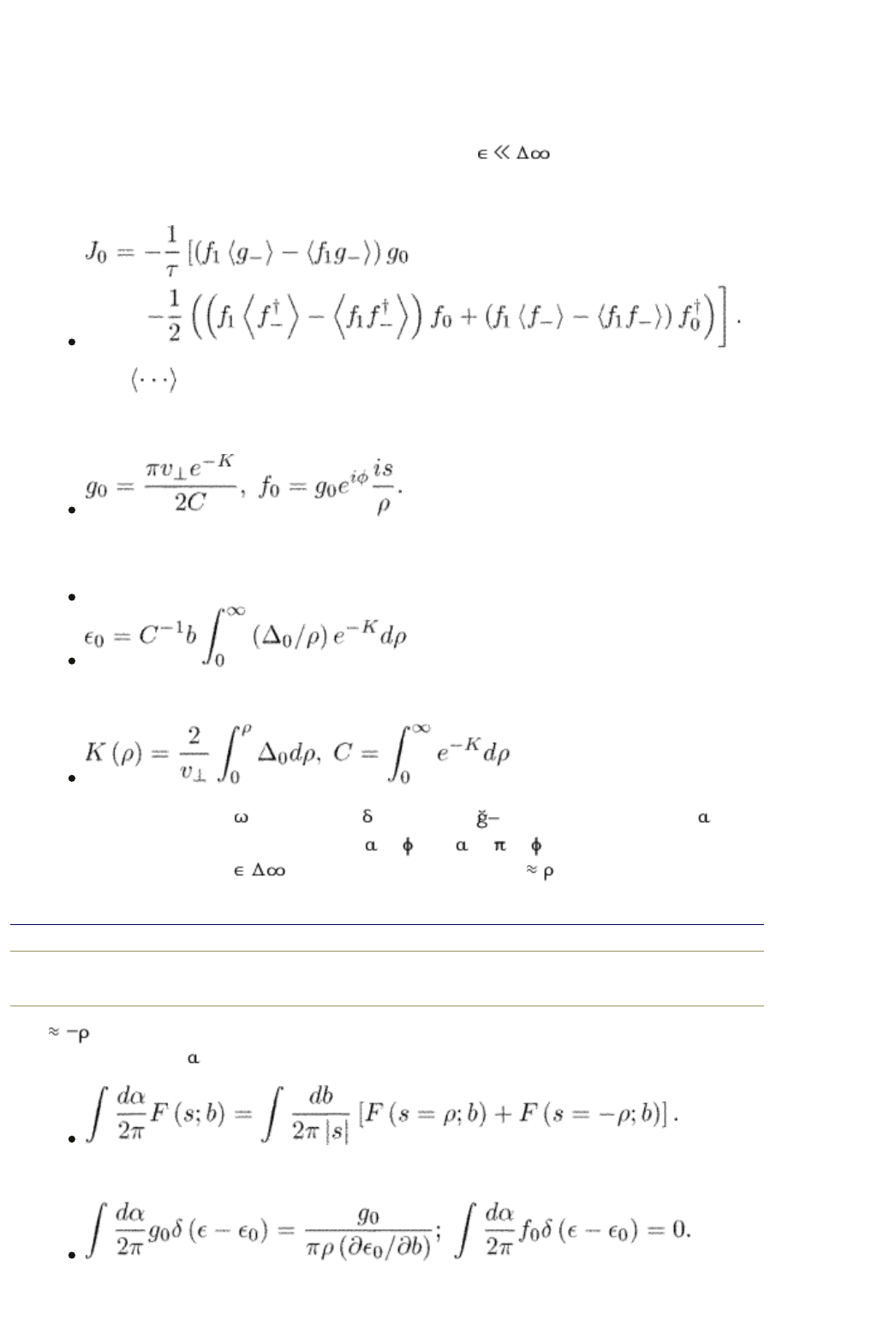
general case. Some simplifications arise when temperatures are much below T
c
.
Only the level with n = 0 is excited at such temperatures. The corresponding
solution was first obtained by Kopnin and Kravtsov (1976 a). For simplicity, we
restrict ourselves to a spherical Fermi surface.
We assume that the scattering by impurities is the primary source of relaxation.
This is the most natural assumption for practically all superconducting materials.
Consider the impurity collision integral for energies
. The spectral weight
for n = 0 in the expansion eqn (14.41) of the collision integral can be found from
eqn (10.74). It has the form
Recall that is the usual average over the Fermi surface. The Green
functions for low energies were found, in Section 8.4. According to eqn (6.83)
the spectral weights are
The bound state energy is given by eqn (6.84).
(14.44)
where
and we neglect a small
c
. Due to the -function in , the integration over d
selects a narrow region of angles near = and = + such that the impact
parameter is small b ~
/ and the distance is either s or
end p.284
s , respectively. Calculating the Fermi-surface averages we will perform the
integration over d
using the rule
As a result
Let us take the distribution function in the form of eqn (14.9) and consider the
PRINTED FROM OXFORD SCHOLARSHIP ONLINE (www.oxfordscholarship.com)
© Copyright Oxford University Press, 2003-2010. All Rights Reserved
Oxford Scholarship Online: Theory of Nonequilibrium Supe... http://www.oxfordscholarship.com/oso/private/content/phy...
第5页 共6页 2010-8-8 16:08
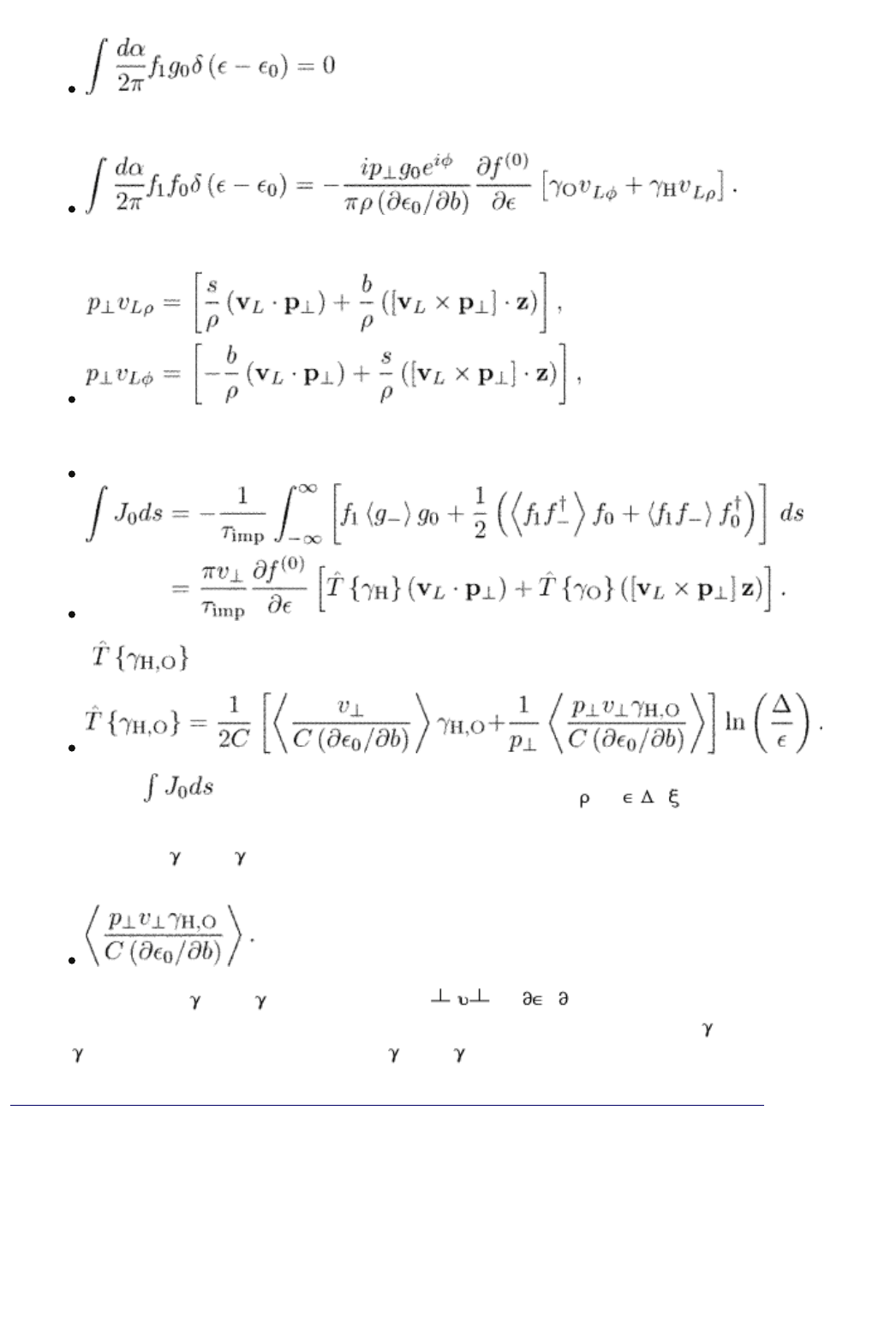
collision integral. Performing the averaging, we have
and
Here we omit contributions proportional to small b. Using
we obtain for the collision integral
(14.45)
where denotes the operator
The integral is logarithmic; the divergence is cut off at ~ ( / ) .
To solve the kinetic equation we insert this into eqn (14.42) and find the
expressions for
O
and
H
in terms of the vortex velocity. These expressions also
contain the averages
Next, we average
O
and
H
with the weight p /C (
0
/ b), solve the
obtained equation for these averages, and exclude thorn from expressions for
O
and
H
. This completes the calculation of
O
and
H
.
end p.285
Top
Privacy Policy and Legal Notice © Oxford University Press, 2003-2010. All rights reserved.
Oxford Scholarship Online: Theory of Nonequilibrium Supe... http://www.oxfordscholarship.com/oso/private/content/phy...
第6页 共6页 2010-8-8 16:08
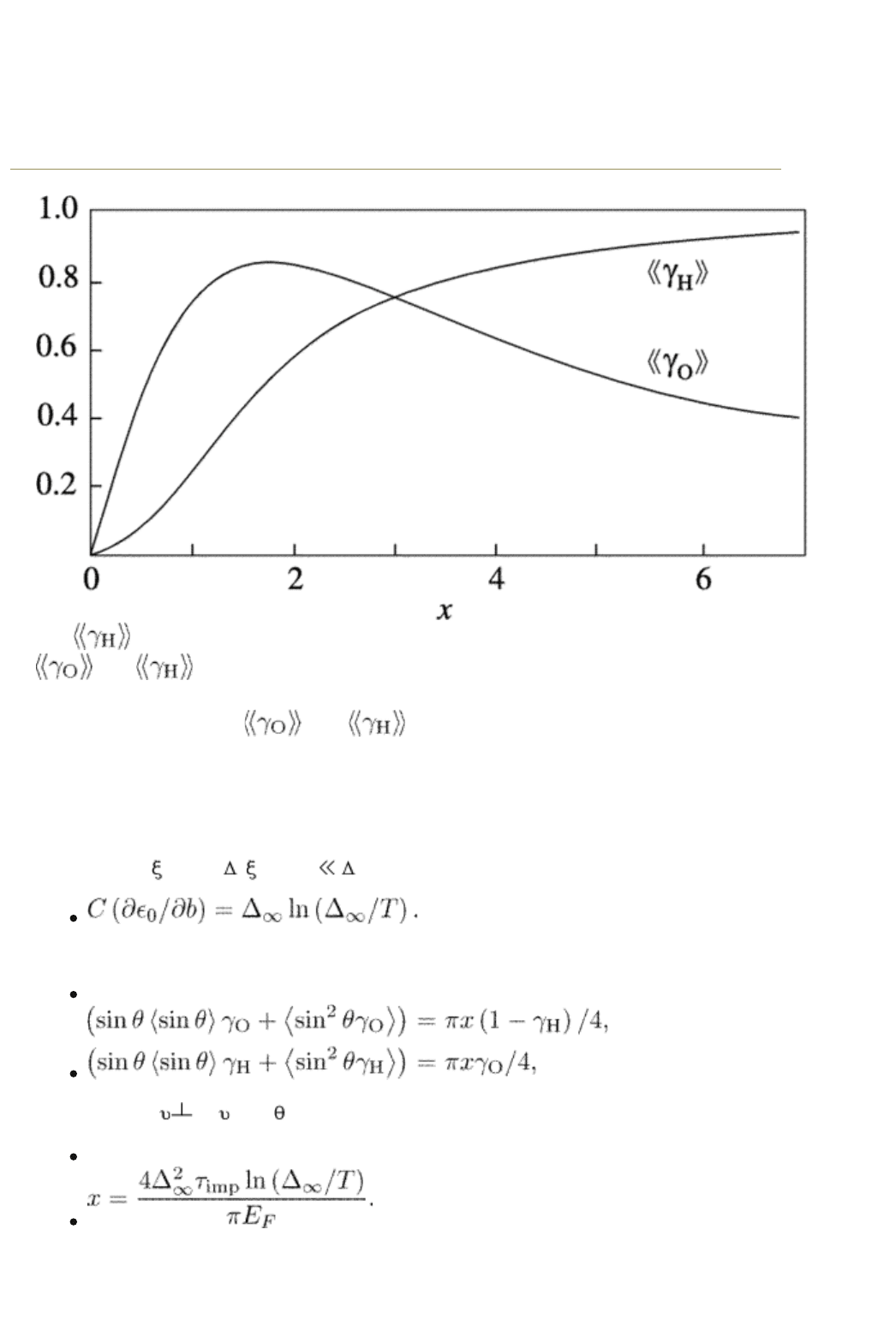
and as functions of the purity parameter x." title="Fig. 14.1. The factors
and as functions of the purity parameter x." class="figure">
F
IG. 14.1. The factors and as functions of the purity
parameter x.
This general scheme of calculations can be carried out explicitly if we make use
of the so-called Kramer-Pesch effect: the compression of the vortex core at low
temperatures. According to Kramer and Pesch (1974) the size of the vortex core
decreases as
1
~ (T/ )
0
for T . In this case one has from eqn (14.44)
Equation (14.42) yields a set of equations
(14.46)
where we put =
F
sin and
(14.47)
One finds from equations (14.46)
Kopnin, Nikolai, Senior Scientist, Low Temperature Laboratory, Helsinki University of
Technology, and L.D. Landau Institute for Theoretical Physics, Moscow
Theory of Nonequilibrium Superconductivity
Print ISBN 9780198507888, 2001
pp. [286]-[290]
Oxford Scholarship Online: Theory of Nonequilibrium Supe... http://www.oxfordscholarship.com/oso/private/content/phy...
第1页 共7页 2010-8-8 16:09
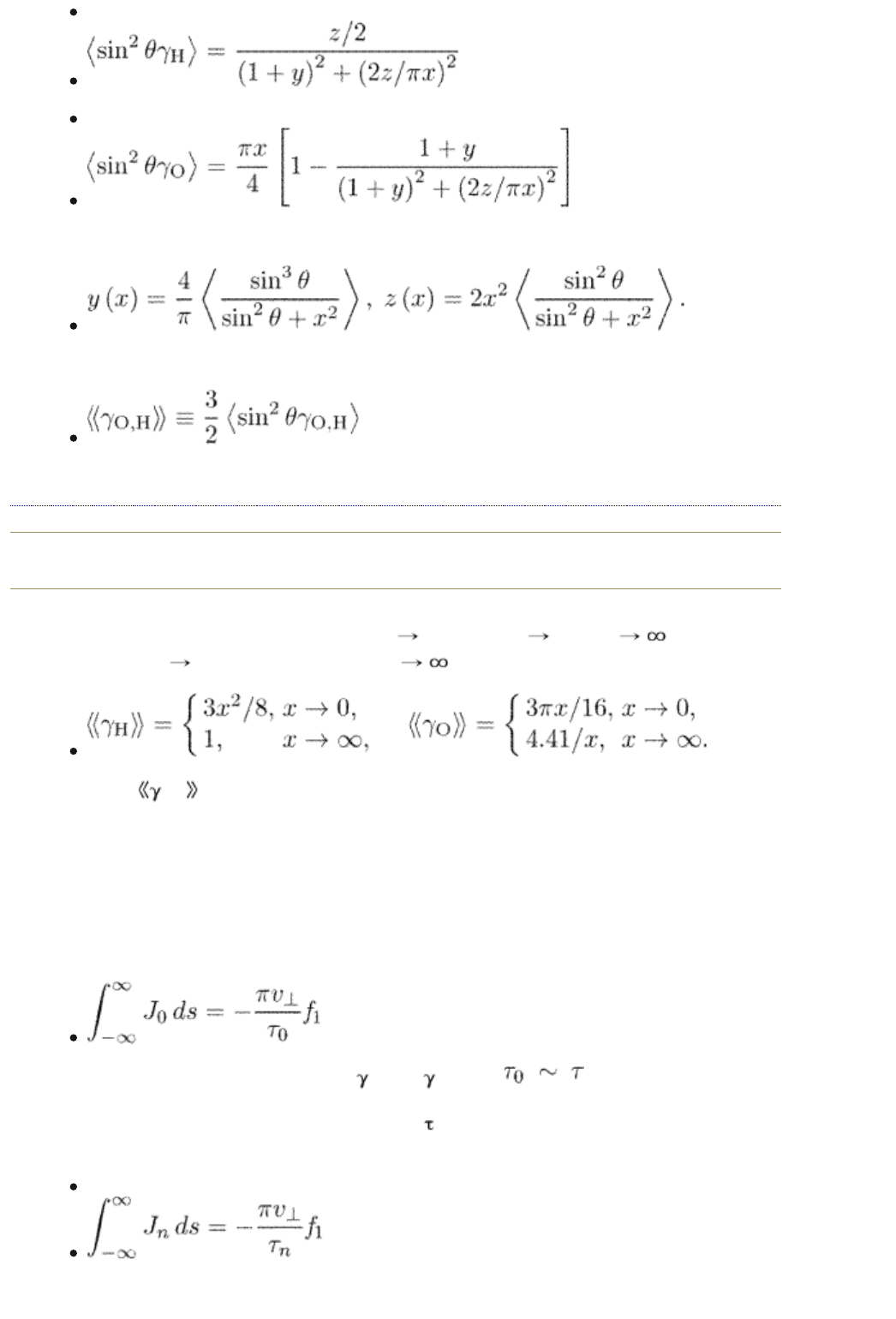
(14.48)
(14.49)
where
We shall see later that these are the values
end p.286
which are needed to calculate the corresponding components of the flux flow
conductivity. The function y (x) = 1 for x
0 and y (x) 0 for x while z
(x) = 2x
2
for x 0 and z (x) = 4/3 for x . Correspondingly,
The factors
O,H
are plotted in Fig. 14.1 as functions of the purity parameter x.
14.4.1.2 Relaxation-time approximation, arbitrary temperatures
The solution of the kinetic equations obtained for low temperatures by Kopnin
and Kravtsov (1976 a) can be generalized to arbitrary temperatures (Kopnin and
Lopatin 1995). To do this we need to simplify the collision integral. Inspection of
eqn (14.45) shows that the collision integral takes the form
if one neglects the p
z
dependence of
O
and
H
. Here is some effective
relaxation time for the low-energy level. To generalize our consideration for
temperatures not much below T
c
we adopt a -approximation for the collision
integral. We assume that
(14.50)
PRINTED FROM OXFORD SCHOLARSHIP ONLINE (www.oxfordscholarship.com)
© Copyright Oxford University Press, 2003-2010. All Rights Reserved
Oxford Scholarship Online: Theory of Nonequilibrium Supe... http://www.oxfordscholarship.com/oso/private/content/phy...
第2页 共7页 2010-8-8 16:09
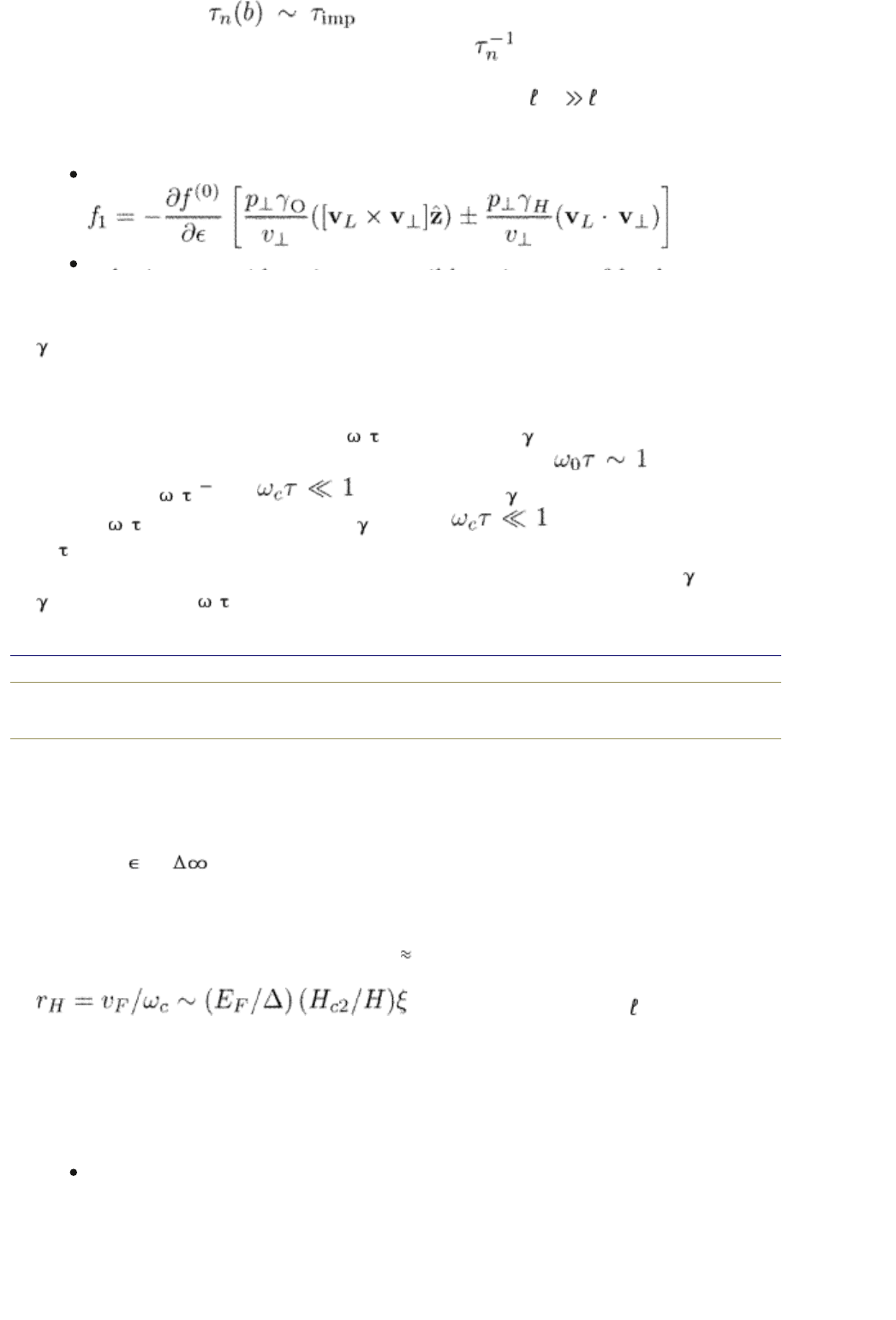
for all states where is the effective scattering time. Within the
relaxation-time approximation the relaxation rate
can also include electron–
phonon and electron–electron collisions. The electron–phonon scattering can be
important for very low concentration of Impurities when
imp
ph
.
We also write the distribution function in a more general form
(14.51)
where we take into consideration a possible existence of both particle-like (the
upper sign) and hole-like (lower sign) carriers in the normal slate. The factors
O,H
arc found from eqn (14.42) with help of eqn (14.50). They are determined
by eqn (14.14) and coincide with the result obtained earlier within the
Boltzmann kinetic equation. Equation (14.14) reproduces reasonably well the
most important feature of the exact expression (14.48) and (14.49) for the
lowest level n = 0: As a function of
0
, the parameter
O
first increases
linearly, reaches the maximum value of the order unity for
and then
decreases as (
0
)
1
for . The parameter
H
grows monotonously
first as (
0
)
2
and then saturates at
H
= 1 for see Fig. 14.1. The use
of
-approximation allows us to find the distribution function for levels with
higher energies, as well. We see that the general trend of the parameters
o and
h as functions of
n
is the same as for the low-energy level.
end p.287
14.4.2 Delocalized excitations
One would expect that, if the density of moving vortices is small enough, the
deviation of the distribution function from equilibrium for the excitations with
energies |
|> should vanish at large distances, where the excitations are in
equilibrium with the crystal lattice or sample boundaries. However, for a finite
vortex density, when the distance between vortices is shorter than the magnetic
field penetration depth, one has to take into account also the motion of electrons
in the magnetic field with the induction B
H, where H is the applied field. Their
behavior is determined by the relation between the Larmor radius
and the mean, free path .
The trajectory of a delocalized quasiparticle crosses many vortex unit cells at
various distances from vortex axes, i.e., at different impact parameters. Since
the distribution function f
1
is constant along the trajectory it should thus be
independent of the impact parameter as well. Let us integrate eqn (14.35) over
the unit cell of the vortex lattice. Using eqn (14.38) we obtain
(14.52)
PRINTED FROM OXFORD SCHOLARSHIP ONLINE (www.oxfordscholarship.com)
© Copyright Oxford University Press, 2003-2010. All Rights Reserved
Oxford Scholarship Online: Theory of Nonequilibrium Supe... http://www.oxfordscholarship.com/oso/private/content/phy...
第3页 共7页 2010-8-8 16:09

The second line gives zero because the functions under the gradient do not
increase with distance; the average gradient should thus vanish. For example,
one can see that
where Q and are the gauge-invariant potentials eqns (1.46) and (1.75)
periodic in a vortex lattice. Using the identity eqn (14.34) we find
(14.53)
The integral of the last term is determined by large distances from the vortex
core where the Green functions g
–
and f
–
are determined by eqn (14.33),
Equation (10.74) results in the collision integral
Therefore,
Inserting this into eqn (14.53) we find the factors
O,H
in eqn. (14.51)
end p.288
(14.54)
where we replace
imp
with for brevity. The primes refer to the fact that these
expressions apply for |
| > The cyclotron frequency is
(14.55)
The modulus of charge appears due to our choice of the z-axis.
PRINTED FROM OXFORD SCHOLARSHIP ONLINE (www.oxfordscholarship.com)
© Copyright Oxford University Press, 2003-2010. All Rights Reserved
Oxford Scholarship Online: Theory of Nonequilibrium Supe... http://www.oxfordscholarship.com/oso/private/content/phy...
第4页 共7页 2010-8-8 16:09
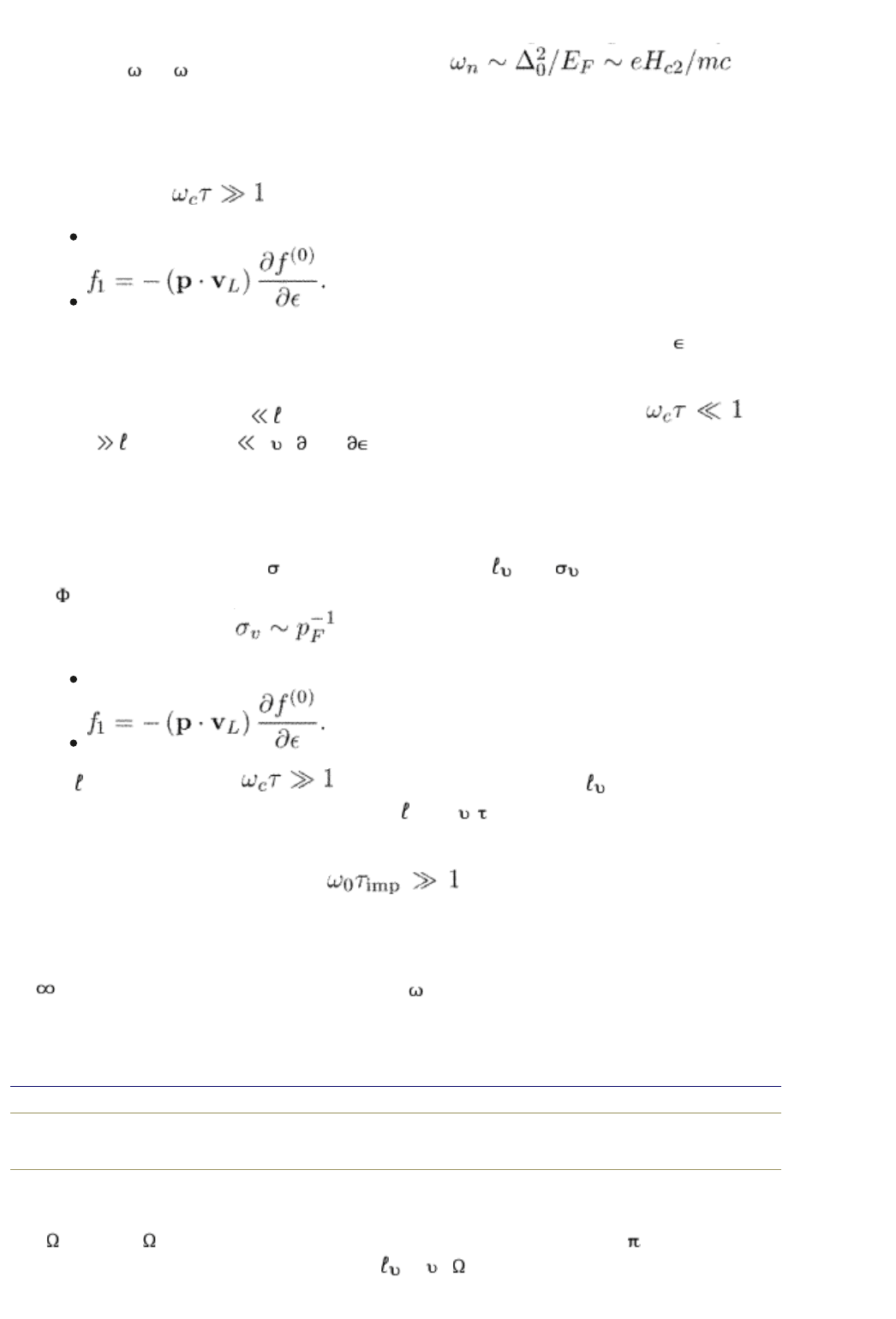
Comparing eqns (14.14) and (14.54) one concludes that localized particles in the
vortex core move like a charge in a magnetic field corresponding to the cyclotron
frequency
c
~
0
. By the order of magnitude, .
One can say that the behavior of localized excitations in the moving vortex is
similar to that of a charge in a magnetic field of the order of H
c2
. This contrasts
to the Bardeen and Stephen (1965) assumption of the effective field being the
external field H.
For high fields,
we obtain for the distribution function in eqn (14.51)
(14.56)
This equation suggests the total distribution function in the form f = f
(0)
( –P ·
V
L
) showing that the excitations move together with the vortex. Indeed,
delocalized excitations cannot relax at the heat bath, since they cannot escape to
distances longer than r
H
, On the contrary, for low fields such that
and r
H
, we have f
1
p
L
( f
(0)
/ ). In this case the delocalized excitations
are almost in equilibrium with the heat bath and do not participate in the vortex
motion.
One can look at this from a slightly different point of view. Consider the mean
free path of delocalized excitations with respect to their collisions with vortices. If
the vortex cross section is
v
, the mean free path is = 1/ n
L
where n
L
=
B/
0
is the density of vortices. We shall see later in Section 14.6.3 that the
vortex cross section is
[compare with eqn (14.100)] so that
(14.57)
i.e., ~ r
H
. In the limit , the vortex mean free path becomes
shorter than the impurity mean free path
imp
=
F imp
so that the delocalized
excitations scatter on vortices more frequently than on impurities and thus come
to equilibrium with moving vortices. A similar consideration also applies to
localized excitations: In the limit
interaction with a vortex is
more effective than relaxation on impurities, the excitations thus relax to
equilibrium with the moving vortex.
The case of low fields corresponds to electrically neutral superfluids, where r
H
=
. At the first glance, it is simply because
c
vanishes together with the charge
of carriers. However, this is not completely correct. In fact, to estimate a
deviation from equilibrium of delocalized excitations in this case one has again
end p.289
to compare the mean free path of excitations with their mean free path with
respect to scattering by vortices. Keeping in mind that the vortex density is n
L
=
2
/k where is an angular velocity of a rotating container and k = /m is the
circulation quantum, eqn (14.57) gives
~
F
/ . We observe that the cyclotron
frequency is replaced with the rotation velocity in a full compliance with the
PRINTED FROM OXFORD SCHOLARSHIP ONLINE (www.oxfordscholarship.com)
© Copyright Oxford University Press, 2003-2010. All Rights Reserved
Oxford Scholarship Online: Theory of Nonequilibrium Supe... http://www.oxfordscholarship.com/oso/private/content/phy...
第5页 共7页 2010-8-8 16:09
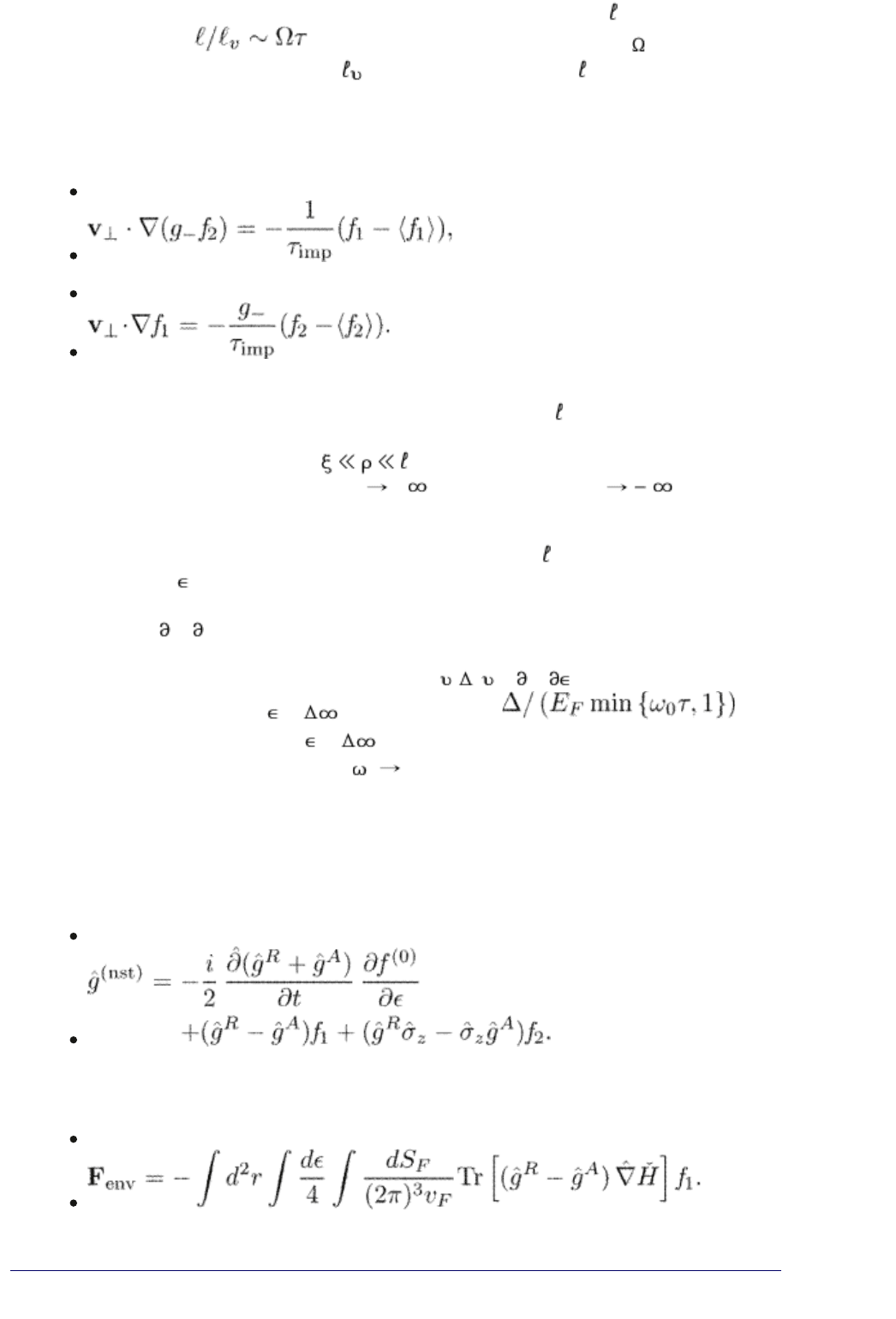
Larmor theorem. The ratio of the particle-particle mean free path to the vortex
mean free path is
. With the practical rotation velocity of a few
radians per second one always has
exceedingly larger than . Delocalized
excitations are thus at rest in the container frame.
Consider this in more detail. The kinetic equations (10.41) and (10.44) at large
distances from the vortex give
(14.58)
(14.59)
We keep the collision integral in the second equation because the distances
which we are interested in are of the order and larger than
, thus eqn (14.36) is
not sufficient, see page 198. The functions f
1
and f
2
are independent of the
distance along the trajectory for
. These constants are coupled to each
other by the conditions f
1
= g
–
f
2
for s + and f
1
= –g
–
f
2
for s which
follow from the fact that eqns (14.58), (14.59) should not have exponentially
increasing solutions. They are the boundary conditions to be imposed at distances
s larger than the core size of the vortex, but shorter than
. For delocalized
excitations with
above the gap at infinity, these boundary conditions give f
1
~
f
2
. As a result both f
1
and f
2
are small. Indeed, since f
1
~ f
2
one can neglect both
the term with
f
1
/ P and the collision integral in eqn (14.35) compared to the
term containing f
2
. The distribution functions f
1
and f
2
which come from eqn
(14.35) are then, by the order of magnitude, (
L
/
F
)( f
0
/ ). Hence the
distribution function f
1
for > is by the factor of
smaller than its magnitude for < and should be considered as zero. This
agrees with eqn (14.54) in the limit
c
0.
14.5 Flux flow conductivity
The force from environment on a vortex is determined by the equation (13.10).
Remind that the nonequilibrium Green function is, according to eqn (13.15)
(14.60)
The main contribution to eqn (14.60) comes from the part containing f
1
. The
force from environment eqn (13.10) becomes
(14.61)
end p.290
Top
Oxford Scholarship Online: Theory of Nonequilibrium Supe... http://www.oxfordscholarship.com/oso/private/content/phy...
第6页 共7页 2010-8-8 16:09

Privacy Policy and Legal Notice © Oxford University Press, 2003-2010. All rights reserved.
Oxford Scholarship Online: Theory of Nonequilibrium Supe... http://www.oxfordscholarship.com/oso/private/content/phy...
第7页 共7页 2010-8-8 16:09
